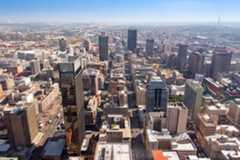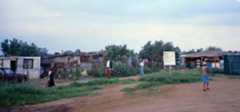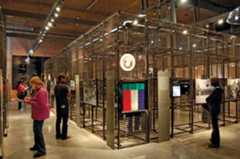Our editors will review what you’ve submitted and determine whether to revise the article.
Johannesburg
- What is Johannesburg known for?
- Where is Johannesburg located in South Africa?
- How did Johannesburg become a major city?
- Why is Johannesburg considered an economic hub in South Africa?
- What is the population of Johannesburg, and what are some key characteristics of its people?
- What are some of the current challenges or issues facing Johannesburg?
News•
Johannesburg, city,Gauteng province,South Africa. It is the country’s chief industrial and financial metropolis.
One of the youngest of the world’s major cities, Johannesburg was founded in 1886, following the discovery of gold. The city was initially part of theTransvaal, an independent Afrikaner, orBoer, republic that later became one of the four provinces of South Africa. Today the city is a part of Gauteng (a Sotho word meaning “Place of Gold”), one of the nine provinces of South Africa.
The geography of Johannesburg reflects nearly a century of racially driven social engineering that reached a climax underapartheid (literally “apartness”), the system ofracial segregation in South Africa from 1948 to 1994. The result is a city of extraordinary contrasts, of glass and steel skyscrapers and fetid shantytowns, of internationally recognized universities and widespread illiteracy, of glittering abundance and desperate poverty. Pop. (2011) city, 957,441; mun., 4,434,631; (2022) mun., 4,803,262.
Physical and human geography
The landscape
The city site
Johannesburg is situated on theHighveld (seeveld), the broad, grassy plateau that sweeps across the South African interior. The city bestrides theWitwatersrand, or Rand, a string of low, rocky ridges thatconstitutes the watershed between the drainages into theIndian andAtlantic oceans. The city’s elevation ranges from 5,700 to 5,930 feet (1,740 to 1,810 metres).
Aside from a few small streams and artificial lakes, Johannesburg lacks water. The city owes its location to the presence of an even moreprecious resource:gold. The city grew on the edge of the Witwatersrand Main Reef, a subterranean stratum of gold-bearing quartz-silica conglomerate that arcs for hundreds of miles beneath the Highveld. Most of the gold mines in the city ceased operation in the 1970s, but in its day the Witwatersrand gold industry accounted for more than 40 percent of the world’s annual gold production. Remnants of the industry—rusting headgear, towering yellow-white mine dumps, copses of dusty Australian bluegum trees imported for underground timbering—still litter the landscape.

Climate
Johannesburg has a temperate climate. Summertime temperatures average about 75 °F (24 °C); winter temperatures average about 55 °F (13 °C) and only occasionally dip below freezing. The city enjoys about eight hours of sunlight per day in both winter and summer. Rainfall averages about 28 inches (700 millimetres) per annum, but the total varies considerably from year to year. Droughts are common. What rain the city receives falls almost exclusively in the summer months, often in spectacular late-afternoon electrical storms. Air pollution poses a significant problem, especially in the winter months, when thermal inversions impede the westward flow of air from the Indian Ocean. Pollution is most severe in the densely settled Black townships on the city’speriphery, where many residents still rely on coal for fuel.
The city layout
Central Johannesburg, the commercial and financial heart of South Africa, is laid out in a rectangular grid pattern that is unchanged from the first city survey in 1886. Streets are narrow and cast into shadow by high-rise concrete blocks, creating an almost tunnellike effect. Architecturally, the city is a hodgepodge, reflecting decades of rapid growth and a singular indifference to historic preservation. The tents and clay huts of the original mining camp are gone, as are most of the ornate, gabled Victorian edifices that sprang up in the 1890s. (Markhams Building, on Pritchard Street, is aconspicuous exception.) The early 20th century brought a variety of architectural styles and movements. Monumental Beaux Arts structures such as the Supreme Court building and the Johannesburg Art Gallerybespoke the city’s new status as an outpost of theBritish Empire, while massive, steel-reinforced concrete blocks such as Corner House, headquarters of one of South Africa’s leading mining houses, reflected the growing importance of American architectural techniques andidioms. American influence was even more apparent in the 1930s “skyscraper” movement, most notably in the 1937ESKOM Building, a 21-storyArt Deco tower built to evoke the vigour ofNew York City. (The ESKOM Building was torn down in 1983, joining a distinguished line of vanished landmarks.) Whatever architectural distinction the city had was lost in the decades afterWorld War II amidst a sea of nondescript high-rise blocks.
Greater Johannesburg, an area of more than 200 square miles,comprises more than 500 suburbs and townships. Under the terms of the 1950Group Areas Act, the cornerstone of urbanapartheid (see below), each was reserved for a single “race group.” The act was repealed in 1991, but Johannesburg retains a high degree of racial segregation.
Black Africans can be found throughout the city, but the majority still live in “townships” on the urban periphery, essentially dormitory cities for Blacks working in the city.Alexandra township, a 20-square-block enclave carved out of Johannesburg’s white northern suburbs, houses a population of nearly half a million. At least three times that number live inSoweto (South-West Townships), a sprawling urban complex 10 miles southwest of the city. Johannesburg’s smallColoured population (people of mixed race) clusters in townships west of the city, while the bulk of its Indian population (ethnic Asians: Indians, Malays, Filipinos, and Chinese) lives inLenasia, a special “Asiatic” township built in the 1950s to accommodate Indians forcibly removed from the city centre. The balance of the city is occupied by whites.
Accommodation varies in character and quality. Soweto isnotorious for its endless rows of municipally built, two-room matchbox homes, yet it also has a few prosperous enclaves as well as teeming squatter camps, where tens of thousands live without water, electricity, or sanitation facilities. Black migrant workers, long the backbone of South Africa’s industriallabour force, are lodged in massive, single-sex hostels located close to the workplace or on the edge of Black townships. White accommodation varies from suburb to suburb. In western suburbs such as Brixton and Melville, middle-class whites live in the modest tin-roofed bungalows and semidetached homes that once housed the city’s white working class. Conditions are bleaker in neighbouring suburbs such as Cottesloe, Vrededorp, and Booysens Reserve, home to most of Johannesburg’s white poor. Moreaffluent whites live in the north, in leafy, establishedcommunities such as Houghton and Parktown, once the residence of South Africa’s mining magnates, or in any of a dozen newer suburbs. Northern suburban homes typically include large, flowering gardens and swimming pools. Most are surrounded by high fences.
















